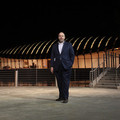的点评
Great view into Nagasaki's Edo Period history
出岛的点评
点评:This is a very interesting part of the city's Edo Period history. It's actually a man-made island that was built for foreigners to trade with the heavily isolationist Japanese of the times (1600s). Nagasaki was one of the only ports open for international trade, but the Portuguese and later Dutch were kept isolated within the walls of Dejima. Only certain members of Japanese society were allowed to interact with them.
Today, the island is entirely recreated back to the Dutch period. There are about 20 or so buildings one can visit, and since they are recreations, most have added modern amenities like air conditioning. Each has a little display of the building's original purpose, plus explanations of the trading system and living style during the Edo Period. It's fascinating.
The exhibits were a lot better than I expected, honestly, and give great insight to a much different part of Nagasaki's history than just the Atomic Bomb. Admission is a bit high at 1,000 yen, but well worth it.
I'd highly recommend stopping here on any visit to the city.
Today, the island is entirely recreated back to the Dutch period. There are about 20 or so buildings one can visit, and since they are recreations, most have added modern amenities like air conditioning. Each has a little display of the building's original purpose, plus explanations of the trading system and living style during the Edo Period. It's fascinating.
The exhibits were a lot better than I expected, honestly, and give great insight to a much different part of Nagasaki's history than just the Atomic Bomb. Admission is a bit high at 1,000 yen, but well worth it.
I'd highly recommend stopping here on any visit to the city.
翻译:这是这座城市江户时代历史中非常有趣的一部分。它实际上是一座人工岛,建造目的是为了让外国人与当时(17世纪)奉行极权主义的日本人进行贸易。长崎是当时仅有的几个对外开放贸易的港口之一,但葡萄牙人和后来的荷兰人都被隔离在出岛的城墙内。只有特定的日本社会成员才被允许与他们互动。
如今,这座岛屿完全恢复了荷兰时期的风貌。岛上大约有20座建筑可供参观,由于是休闲娱乐,大多数都配备了空调等现代化设施。每座建筑都略微展示了其最初的用途,并解释了江户时代的贸易体系和生活方式。这真是令人着迷。
说实话,这些展览比我预想的要好得多,它们不仅展现了原子弹爆炸,还让我们深入了解了长崎历史中截然不同的部分。门票价格略高,为1000日元,但绝对物有所值。
我强烈建议您在游览这座城市时在此停留。
如今,这座岛屿完全恢复了荷兰时期的风貌。岛上大约有20座建筑可供参观,由于是休闲娱乐,大多数都配备了空调等现代化设施。每座建筑都略微展示了其最初的用途,并解释了江户时代的贸易体系和生活方式。这真是令人着迷。
说实话,这些展览比我预想的要好得多,它们不仅展现了原子弹爆炸,还让我们深入了解了长崎历史中截然不同的部分。门票价格略高,为1000日元,但绝对物有所值。
我强烈建议您在游览这座城市时在此停留。
此点评仅代表旅行者个人的主观意见,并不代表TripAdvisor以及其合作方的意见。
关于我们
|
新闻动态
|
商务合作
|
会员中心
|
业主中心
|
业主通
|
常见问题
|
意见反馈
|
联系我们
|
营业执照
© 2025 Tripadvisor 版权所有。
使用条款 |隐私政策 |网站工作原理
部分照片由 VFM Leonardo 提供。
* Tripadvisor不是旅行社,也不是旅游预订服务代理商。我们提供免费、客观、公正的旅游资讯服务。 (显示更多)
TripAdvisor LLC 既不是预订代理商,也不是旅游运营商,不会向网站用户收取任何服务费。 按照规定,在 Tripadvisor 发布机票价格、游览和旅行套餐的合作伙伴(航空公司、旅行提供商及预订代理商),其标价须包含所有费用和附加费用。 例如, 机场出入境税费、消费税与其他服务费、手续费、杂费及附加费用。 当您向我们的某个合作伙伴进行预订时,请务必查阅他们的网站以了解当地行政部门要求的所有适用费用的具体情况。 除非另有说明,机票价格通常指的是一个人的价格(以人民币计)。
为方便起见,TripAdvisor LLC 根据从我们的预订合作伙伴获取的空房率计算每个酒店的均价。 对于游览和景点来说,所显示价格通常是每位成人的最低可用价格。 对于列出的任何旅行套餐或优惠,TripAdvisor LLC 无法保证任何特定的费率或价格。 此外,酒店均价每晚会更新,并以您的首选币种表示(使用现行汇率)。 由于这些已换算的价格是预估价格,因此,有关具体金额和币种请与预订网站进行核实。
此外,TripAdvisor LLC 无法保证我们网站上宣传的价格随时有效。 标价可能需要预订一定天数才能生效,或有不可用日期、使用条件或限制。
TripAdvisor公司对外部网站的内容一概不负责。优惠价格中不含税和其他费用。
ICP证:沪B2-20200433
沪ICP备20013175号
 沪公网安备31010502005427号
沪公网安备31010502005427号鹰程信息技术(上海)有限公司
货币/国家及地区
¥CNY
中国

